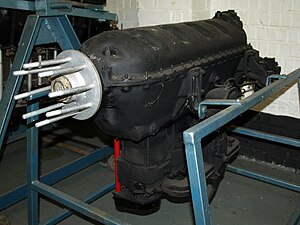The de Havilland Gipsy Minor or Gipsy Junior is a British four-cylinder, air-cooled, inline engine that was used primarily in the de Havilland Moth Minor monoplane, both products being developed in the late 1930s.
| Gipsy Minor | |
|---|---|

| |
| de Havilland Gipsy Minor at the de Havilland Aircraft Heritage Centre | |
| Type | Piston inline aero-engine |
| Manufacturer | de Havilland Engine Company |
| First run | 1937 |
| Major applications | de Havilland Moth Minor Short Scion |
| Number built | 171 |
| Developed from | de Havilland Gipsy |
Design and development
editThe engine was a simplified and smaller version of the earlier de Havilland Gipsy. It featured only one magneto where dual ignition was normal for the Gipsy series of engines. A total of 171 engines were produced, including 100 built in Australia as production moved to that country due to the start of the Second World War.[1]
Applications
editEngines on display
edit- A de Havilland Gipsy Minor engine is on public display at the de Havilland Aircraft Heritage Centre, London Colney, Hertfordshire.
Specifications (Gipsy Minor)
editData from [2]
General characteristics
- Type: 4-cylinder air-cooled inverted inline piston aircraft engine
- Bore: 4.016 in (102 mm)
- Stroke: 4.528 in (115 mm)
- Displacement: 229.29 in³ (3.759 L)
- Dry weight: 216 lb (98 kg)
Components
- Valvetrain: Overhead valve
- Fuel type: Minimum 70 octane petrol
- Oil system: Dry sump, gear-type pump
- Cooling system: Air-cooled
Performance
- Power output: 90 hp at 2,600 rpm
- Compression ratio: 6:1
- Power-to-weight ratio: 0.41 hp/lb
See also
editRelated development
Comparable engines
Related lists
References
editWikimedia Commons has media related to De Havilland Gipsy Minor.
Notes
editBibliography
edit- Lumsden, Alec. British Piston Engines and their Aircraft. Marlborough, Wiltshire: Airlife Publishing, 2003. ISBN 1-85310-294-6.